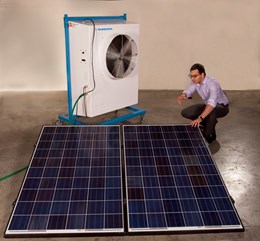-
.jpg?w=260&mode=crop)
Current energy consumption trends in commercial buildings highlight the urgent need for improved energy efficiency. Inefficient HVAC systems not only drive up operational costs but also contribute significantly to environmental degradation through higher CO2 emissions. Through developing a service and maintenance strategy, using digital insights to review the existing equipment and systems, giving a baseline on the energy consumption and what system improvements could be made, businesses and building owners can expect to see improvements in energy efficiency, enhance indoor air quality, and reduce both costs and carbon footprints.
-

Through a strategic research partnership focused on CERN’s cooling and ventilation systems, energy efficiency audits have helped to identify a savings potential of 17.4% across a total of 800 motors
-

The city state is looking at greener energy sources and wants to make every aspect of data center energy consumption, from cooling to coding, more efficient.
-

Many people in Japan are taking note of the oncoming cold season as national electric bill subsidies come to an end in October. What are some methods to save on winter bills when keeping one's home warm?
-

Their device needs no electricity, as it extracts water from the air using nothing more than gravity and relies on cheap, readily available materials.
-
.jpg?w=260&mode=crop)
Researchers have created an advanced refrigeration device that combines eco-friendliness with unprecedented cooling efficiency. The system achieves a temperature lift of 75 K by expanding the super elastic temperature window of NiTi shape memory alloys.
-

The problem is only going to grow as high-powered AI-based computers and devices become commonplace. That's why University of Missouri researcher Chanwoo Park is devising a new type of cooling system that promises to dramatically reduce energy demands.
-

On September 12, 2024, the Ministry of Industry and Trade, in collaboration with the Danish Energy Agency and the Danish Embassy, organized a technical seminar on “Consultation on industrial cooling catalogue, ventilation catalogue, heat recovery and heat pump guideline”. This seminar is part of the Energy Partnership programme between Vietnam and Denmark 2020 - 2025 (Depp3), funded by the Danish government.
-

GeckoLogic firm developed an evaporative cooler that has an integrated photovoltaic system isolated from the electrical network, which enables to refresh an area of approximately 200 square meters.
-

Every year, the information technology sector spends almost $7 billion on electricity costs, and much of that money goes to cooling computer processing units (CPUs) in data centers. At the Energy Department’s Sandia National Laboratories, researchers have developed an innovative new air-cooling technology - the Sandia Cooler - that improves the way heat is transferred in computers and microelectronics, significantly reducing the energy needed to cool CPUs in data centers.
-

The group ISA Tracto C replaced diesel with kinetic energy, saving up to 20 thousand liters of fuel annually.
-

Nearly 40 % of energy consumption in the EU goes to heating, cooling and lighting buildings. Their energy demands account for large amounts of carbon dioxide emissions.
-

Riverside Church has a storied past that includes appearances by Nelson Mandela, the Rev. Martin Luther King and former President Clinton. Now, thanks to a modernization of its heating and cooling systems, the church has a more energy-efficient future.
-

A natural gas development platform in the Gulf of Thailand, operated by Carigali-PTTEPI Operating Company Sdn. Bhd. (CPOC), has saved $52 million per year and significantly reduced water usage and chemical consumption with help from General Electric’s advanced cooling and chemical treatment technology.
-

A patented passive cooling system for computer processors that’s undergoing optimisation at The University of Alabama in Huntsville (UAH) could save U.S. consumers more than €5.6 billion per year in energy costs associated with running their computer cooling fans.
-

This elegant-looking Climatic Table can regulate indoor temperatures by storing heat and increases energy savings by up to 60% for heating and 30% for cooling.
-

To combat this the HRS system uses waste heat from the plant’s CHP engine via the engine’s cooling water and also recycles the heat (through heat exchanger tubes) used during the pasteurisation process to reduce energy consumption by up to 70%.
-

Valmet has launched a new and patented calendering technology to the market. The new aqua cooling technology improves the calendering results compared to usual paper production conditions.
-

Ductless air conditioning is ideal for cooling a home or a room which is not equipped with the traditional HVAC ductwork.
-

The electricity price has increased by 7.5%, so consumers tend to give priority to power-saving products, especially cooling items.
.jpg?w=260&mode=crop)




.jpg?w=260&mode=crop)














 Webinar 2: “Financial Support for Energy Efficiency Enterprises – Opportunities and Challenges”
Webinar 2: “Financial Support for Energy Efficiency Enterprises – Opportunities and Challenges”
 Vietnamese enterprises achieve green growth and cut costs through energy efficiency
Vietnamese enterprises achieve green growth and cut costs through energy efficiency
 Capacity Building for Program Implementing Entity
Capacity Building for Program Implementing Entity
 Enhance Energy Efficiency Knowledge for Managers of Cement Industrial Enterprises
Enhance Energy Efficiency Knowledge for Managers of Cement Industrial Enterprises
 Capacity building for participating financial institutions in Ho Chi Minh City
Capacity building for participating financial institutions in Ho Chi Minh City
 Strengthening capacity for energy management officers of local government agencies
Strengthening capacity for energy management officers of local government agencies
 Strengthening Sales and Marketing Capacity for Energy Efficiency Equipment and Solution Suppliers
Strengthening Sales and Marketing Capacity for Energy Efficiency Equipment and Solution Suppliers